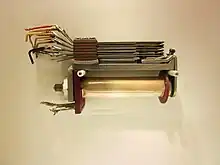Z5 (computer)
The Z5 was a computer designed by Konrad Zuse and manufactured by Zuse KG following an order by Ernst Leitz GmbH in Wetzlar in 1950. The computer was delivered in July 1953[1] and was the first commercial built-to-order mainframe in Germany. The computer was purchased to help with the design of optical lens systems.
| Developer | Konrad Zuse |
|---|---|
| Manufacturer | Zuse KG |
| Release date | July 1953 |
| Lifespan | 5 years |
| Introductory price | DM 300,000 (equivalent to DM 812,445 in 2021) |
| CPU | @ ca. 40 Hz |
| Memory | 720 relays, 36 bit word length, 12 cells |
| Power | 5000 watts |
| Mass | Ca. 2,000 kg (4,400 lb) |
| Predecessor | Z4 |
The Z5 is the successor of the Z4, and is much more compact and powerful. Zuse implemented the machine with relays, since vacuum tubes were too unreliable at the time. The Z5 used the same principles as the Z4, but was six times faster. It also had punched tape readers, which the Z4 did not have. It had conditional branching and five subroutine loops.
Specifications
References
- Kaisler, Stephen H. (2016). Birthing the Computer: From Relays to Vacuum Tubes. Cambridge Scholars Publishing. p. 15. ISBN 9781443896313.
- "Z5". www.horst-zuse.homepage.t-online.de (in German).
- Research, United States Office of Naval (1953). A survey of automatic digital computers. Office of Naval Research, Dept. of the Navy. p. 98.
External links
This article is issued from Wikipedia. The text is licensed under Creative Commons - Attribution - Sharealike. Additional terms may apply for the media files.
